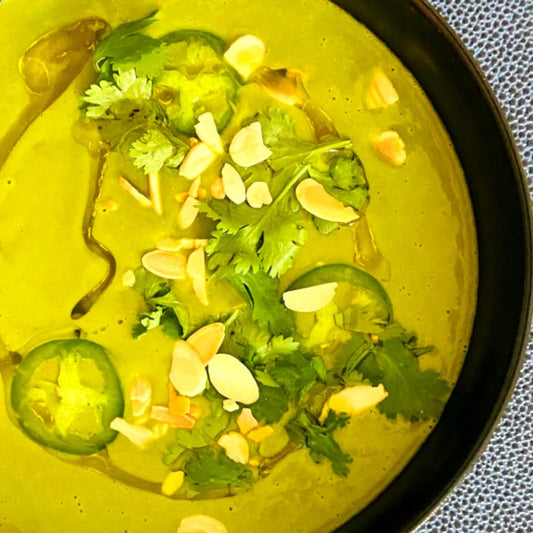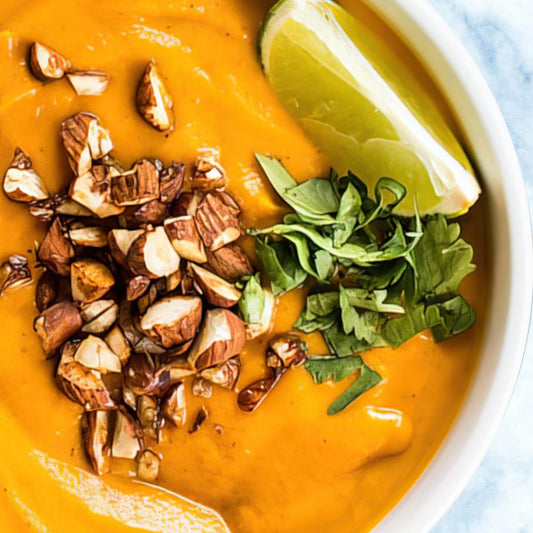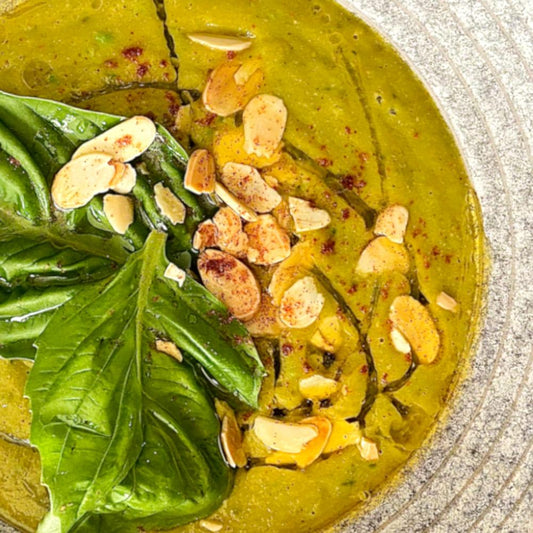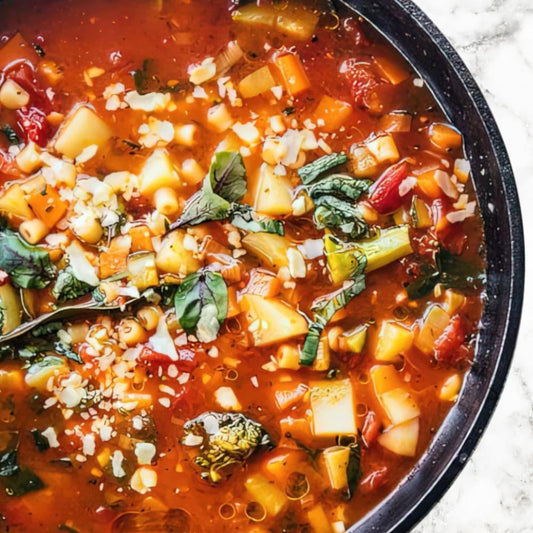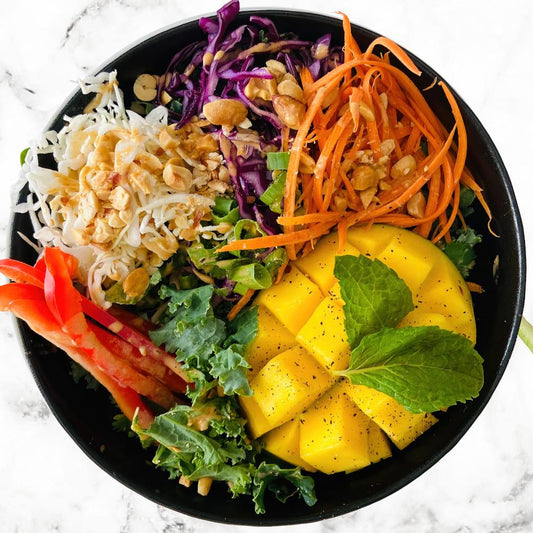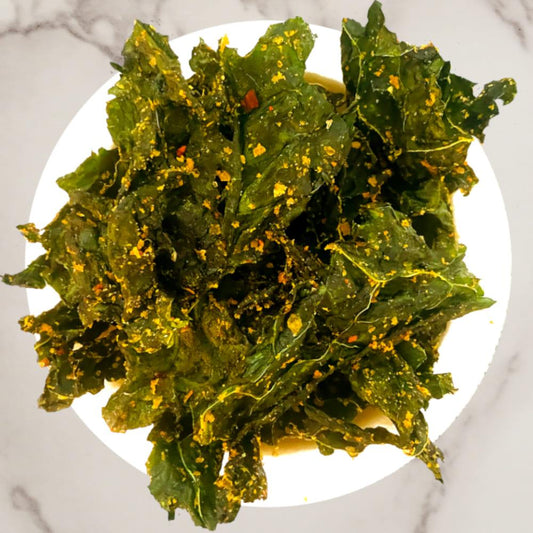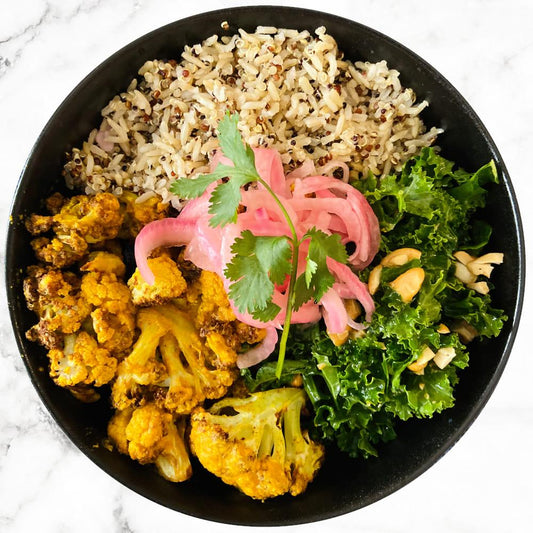This member of the cabbage family originated in Europe and Asia around 2,000 BCE, making it a staple in the human diet for over 4,000 years. The cabbage family, also called the Brassicaceae family, includes bok choy, broccoli, cabbage, Brussels sprouts, cauliflower, and, of course, kale—all things green and leafy.
After all, the root of the word "Brassica" was the term used in early Rome for leafy green plants.
During the Middle Ages, kale was particularly popular among Italians, Scots, and Russians. The different varieties of kale they grew filled their diets with vitamins and nutrients that helped them survive the harsh winters.
In Scotland, this vegetable became such an important food that in some local Scottish dialects, the term "kail" was used in place of "food," and the phrase "come to kale" served as an invitation to dinner!
Kale was brought to the US in the mid-1600s and, since then, has become one of the most popular superfoods in the country.
It’s grown primarily in California, Georgia, and New Jersey, but can be found in just about every state in the US. It grows best in cooler weather and is among the most nutrient-dense foods on the planet, providing a great source of vitamins A, C, and K.
You don’t want to miss out on the amazing health benefits of kale! So let’s get into the nitty-gritty of what makes kale so special.

Nutritional Value of Kale
Kale, a member of the cabbage family, is often hailed as a superfood due to its impressive nutrient content. Let’s dive into its nutritional value:
- Calories: One cup of raw kale (20.6g) provides a mere 7.2 calories.
- Carbohydrates: It contains 0.9g of carbs, primarily in the form of fiber (0.8g of the total grams).
- Protein: Kale offers less than 1g of protein per serving, but the protein it does contain is easily digestible.
-
Vitamins:
- Vitamin A: Provides 49.6mcg.
- Vitamin K: Rich in 80.3mcg.
- Vitamin C: Offers 19.2mg.
-
Minerals:
- Potassium: Provides 71.7mg.
- Calcium: Contains 52.3mg.
- Also includes trace amounts of manganese, copper, and some B vitamins.
- Fats: There is almost negligible fat content, but cooking methods can alter this.
- Glycemic Load: Estimated at 3, making kale a low-glycemic food.
-
Health Benefits:
- Antioxidants: Supports heart health and decrease cancer risk.
- Vitamin K: Important for blood clotting.
- Plant-Based Calcium: Ideal for vegetarian and vegan diets.
- Recommended Quantity: For healthy individuals, aim for one to two cups of kale per day. Consult your doctor if you have specific health conditions or take medications.
The Top Health Benefits of Kale

Kale is heart-healthy
Kale contains potassium, a mineral that helps maintain the electrical signals from your brain to your heart. The upkeep of these signals keeps the heart beating at a regular pace—this is incredibly important, as an abnormal heart rhythm can lead to heart attack and cardiac arrest.
Potassium also relaxes arteries, helping to lower blood pressure and maintain a healthy heart.
Besides that, kale contains substances called bile acid sequestrants that reduce the amount of cholesterol in the body, leading to a reduced risk of heart disease over time. Studies have shown that if kale is juiced or steamed, it still has these benefits.

Kale is also a good source of magnesium, and eating plenty of magnesium may be protective against heart disease and type 2 diabetes.
Kale helps support bone health
Kale is high in minerals that many people are deficient in, including calcium! It is a fantastic source of plant-based calcium, which is needed for strong bones and teeth. It also contains oxalate, which makes calcium more available for absorption in the body.
Kale is also a great source of vitamin K, which works with vitamin D to support a healthy bone metabolism. Research indicates that a high intake of vitamin K strengthens the bones and helps reduce the risk of bone fractures.
Kale helps support skin and hair health
Vitamin A helps the growth of all body tissues, including skin and hair. Without enough vitamin A, the risk of developing eczema and other skin inflammation problems increases. A healthy vitamin A intake should result in a soft, oily scalp and skin. It may also strengthen the hair and prevent premature hair loss.
Luckily, kale is a great source of beta-carotene, which the body converts into vitamin A when needed.
Kale also contains vitamin C, which the body uses to build and maintain collagen, which is a protein that provides structure to skin, hair, and bones.
Kale helps lower risk of Diabetes
A higher consumption of fruits (particularly berries), leafy green vegetables, yellow vegetables, and cruciferous vegetables was found to be associated with a lower risk of developing type 2 diabetes, according to a meta-analysis that was published in the Journal of Diabetes Investigation.
The researchers believe that this is due to a number of different variables, including as the high fiber content (which lowers insulin resistance and promotes satiety), as well as the presence of antioxidant chemicals (including vitamin C), folate, and potassium.

Consuming around one cup of dark leafy greens, such as spinach and kale, on a daily basis can reduce the chance of developing type 2 diabetes by fourteen percent, as concluded by an evaluation of the relevant studies. Although the explanation for this is not entirely known, it is possible that the protective impact of leafy greens is due to the presence of antioxidants such as vitamins A and C when consumed.
According to the United States Department of Agriculture (USDA), one cup of fresh, cooked kale that does not have any added oil contains 172 micrograms of vitamin A, which is equivalent to around 20 percent of the daily value, and 21 milligrams of vitamin C, which is equivalent to approximately 25 percent of the DV. Individuals who have type 2 diabetes would benefit greatly from the consumption of leafy greens because they are low in both calories and carbohydrates (a single serving of kale contains just 6.3 grams of carbohydrates and 52 calories).
Kale supports Digestive Health
It is possible to avoid and treat constipation, as well as maintain regular bowel movements, by consuming sufficient amounts of fiber and water. Because it includes fiber, kale helps to make stools more bulky.
Moreover, kale is a source of prebiotics, which are essential components of a diverse microbiome, which is a healthy collection of bacteria that live in the gut. The presence of a diverse population of microorganisms in the gut has been associated with a lower risk of a number of diseases, including diabetes, Alzheimer's disease, and others.
Buying Kale: What to Look For
Kale from the winter harvest has thicker, curlier, and larger leaves which are great for cooking hearty, wintery meals.
Besides the harvesting season of kale, the type of kale also matters when you’re looking for the best produce for your buck. There are four main types of kale to look out for.
Curly kale has bright green leaves that are lighter in color than other kale varieties. It isn’t commonly eaten raw because of its bitterness, but tastes great when sauteed, or served with flavorful sauces.
Dinosaur kale, also called Tuscan kale, has darker, longer, crinkly leaves with a light stem. This variety keeps its firmness even after cooking, making it perfect for soups and stews.

Scottish kale has leaves with a flatter and more tender structure that curl up at the ends. The darker leaves are great for cooking, and the lighter leaves are great for raw food preparations.
Red Russian kale has a dusty purple tinge. The stems are much longer, and the leaves are narrower with crinkles at the edges. This variety is most popular for salads.
Regardless of the kale variety you’re looking for, it should have bright, crisp leaves. Make sure to avoid any yellowing kale. This is an indicator that it’s past its best-by date.
Once you bring the kale back home, it is recommended to keep it in an airtight container or storage bag in the refrigerator. Kale's shelf life is 5 days at most. If kept in the fridge for too long, it’ll start turning soft, yellow, and extra bitter.
Cooking With Kale
Kale has amazing variety when it comes to recipes. Its vibrant, eye-catching color can brighten up any meal, and its distinct yet subtle flavor adds a richness to food that can’t be found in any other ingredient.
Eaten raw, steamed, braised, boiled, or sautéed, kale goes great in everything from salads to casseroles. But, before cooking with kale, it has to be prepared. This only takes a couple of seconds once you get the hang of it.
First, wash the kale by submerging it in a large bowl of water and swishing the leaves around to remove dirt. Then, rinse it under fresh water and dry it on cloth or paper towels. Chop the kale into 1-inch-wide strips, or as described in the recipe, and discard the bottom of the stems without removing the ribs.
Once prepared, the kale is ready to be cooked or used in unique raw food preparation!

If you would like to eat the kale raw, scrunching the leaves briefly in your hands will make them easy to digest. Skipping this step will leave the leaves tough and unsavory.
Once massaged, raw kale can be added to salads, sandwiches, or wraps.
For a simple side dish, you can sauté fresh garlic and onions in olive oil until soft. Then, add kale and continue to sauté until it is perfectly tender. Alternatively, you can steam kale for 5 minutes, then drain and stir in soy sauce and tahini for a flavorful addition to a main course.
Kale chips are also a great treat! To create them, all you have to do is remove the ribs from the kale and toss the leaves in olive oil or lightly spray them with cumin, curry powder, chili powder, roasted red pepper flakes or garlic powder. Bake them at 275°F for 15-30 minutes until you have perfectly crispy kale chips!
Smoothies can also be great kale creations. Just add a handful of kale, plus any of your other favorite fruits and vegetables, into a blender along with ice, juice, milk, and/or yogurt. The kale won’t affect the flavor of the smoothie much but will make it so much more nutritious!
Best ways to eat Kale
Eating kale in either its raw or cooked form is beneficial to one's health. However, when you cook kale, you are more likely to consume a larger quantity, which results in an increase in the amount of nutrients that you take in. Glucosinolates are increased to their maximum potential when kale is steamed, according to some research.
It is recommended that you consume kale with a fat that is beneficial to your heart, such as extra-virgin olive oil or avocado oil, in order to facilitate the absorption of fat-soluble vitamins.
Baby kale, curly kale, Tuscan kale, red or red Russian kale, Redbor kale, and baby kale are some of the most common varieties of kale that you can get in the market in the United States. In the event that you have never used this vegetable previously, you have a wide variety of possibilities available to you. Take advantage of a wide range of nutrients, flavors, and textures by experimenting with a variety of varieties and colors.

Kale can be steamed and served alongside your preferred whole grain, legume, fish, or lean protein source. It can also be chopped and tossed with extra virgin olive oil for salads, added to soups and smoothies, blended into dips, or steamed by itself. Because of its adaptability, kale can be included into a wide range of different cuisines.
Smoothies can also be great kale creations. Just add a handful of kale, plus any of your other favorite fruits and vegetables, into a blender along with ice, juice, milk, and/or yogurt. The kale won’t affect the flavor of the smoothie much, but it will make it so much more nutritious!
Frequently Asked Questions (FAQ) about Kale
1. What is kale?
Kale is a fantastic, nutritious source of vitamins A, C, and K, as well as being packed with a host of antioxidants. It’s easy to pick and can be incorporated into various meals, including smoothies, curries, and salads.
2. What are the health benefits of kale?
Kale contains a multitude of health benefits. As a cruciferous vegetable, it is rich in vitamin K and antioxidants, which are highly beneficial for heart health. Additionally, it is a good source of calcium and supports eye health due to its high levels of lutein and zeaxanthin.
3. What are the different types of kale?
There are several common types of kale, including curly kale, dinosaur kale, and Russian kale. Each type has its own unique nutritional profile and can be utilized in various culinary applications.
4. How does kale contribute to nutrition?
Kale is a powerhouse of nutrition. It is packed with essential vitamins and minerals, making it an excellent addition to any diet. Whether cooked or raw, kale is a valuable source of essential nutrients.
5. What are some common kale recipes and preparations?
Kale can be incorporated into various dishes, such as kale chips, salads, stir-fries, smoothies, and soups. Its versatility and distinct flavor make it a popular choice for health-conscious individuals.
6. How can one effectively incorporate kale into their diet?
Adding kale to your diet can be as simple as including it in smoothies, sautés, and salads. Additionally, exploring different cooking methods and recipes can help in making kale a regular part of your meals.
7. What precautions should be taken when consuming kale?
While kale is highly nutritious, it is important to consider the following precautions:
-
Oxalates and Kidney Stones: Kale contains oxalates, which can increase the risk of kidney stones. If you’re prone to kidney stones, limit your kale intake.
-
Goitrogens and Thyroid Health: Kale contains goitrogens, substances that can interfere with thyroid hormone synthesis. Excessive intake may increase the risk of iodine deficiency. If you have thyroid issues, consult your doctor.
-
Iron Toxicity: Kale is rich in iron. While this is generally beneficial, excessive consumption can lead to iron toxicity. Balance your intake with other iron rich sources such as legumes, nuts, seeds and dark leafy greens.
-
Digestive Health: Kale is high in fiber, which aids digestion. However, consuming too much can lead to constipation or stomach irritation. Ensure adequate water intake to prevent digestive discomfort.
-
Storage and Freshness: To prevent food poisoning, store kale properly in the fridge and check for signs of spoilage. Consume fresh and healthy kale to avoid any risks.
8. How do I sauté kale?
Sautéed kale is a great way to enjoy this leafy green. Remove tough stems and ribs, chop the leaves, and sauté them in oil until tender and wilted.
9. What’s the secret to making crispy kale chips?
For oven-baked kale chips, drizzle torn kale leaves with olive oil, season with salt, and bake until crisp. Keep an eye on them to prevent burning.
Adding kale to your diet can be as simple as including it in smoothies, sautés, and salads. Additionally, exploring different cooking methods and recipes can help in making kale a regular part of your meals.
10. Is cooked kale still nutritious?
11. Is kale and seaweed the same thing?
No, kale and seaweed are not the same. Kale is a leafy green vegetable, while seaweed refers to a diverse group of marine algae.
12. Is cooked kale still nutritious?
13. Raw or cooked kale: Which is better?
Cooking kale can make it more palatable and easier to digest. However, some cooking methods reduce antioxidants and minerals. Steaming or lightly sautéing kale is a good compromise.
14. How do I remove bitterness from kale?
Blanching or sautéing kale can help reduce bitterness. Pair it with flavorful ingredients like garlic, lemon, or vinegar to balance the taste.
15. Can I microwave kale?
NOURISH Items with Kale
Organic Crispy + Cheesy Kale Chips w Roasted Sunflower Seeds [vegan] [gluten free]
Organic Crispy + Spicy Sriracha Kale Chips w Garlic [vegan] [gluten free]
Roasted Cauliflower Tikka Masala Salad Bowl w Local Honey Pickled Onions [vegan] [gluten free]
Caesar Salad with Chickpea Croutons + Roasted Potatoes [vegan] [gluten free]


